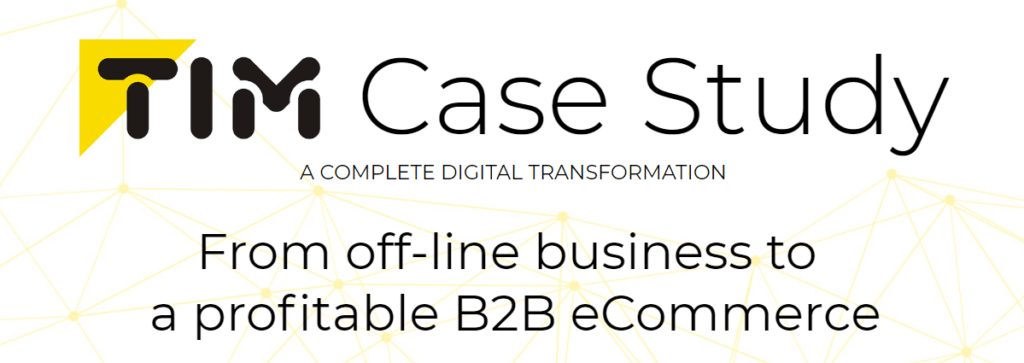Developing a B2B eCommerce differs from B2C – it is obvious. It’s not about the numbers itself – the crucial difference here is the customer. Business and individual customers purchase for various reasons and expect different experiences during their online shopping.
One of the main differences is that business customers’ purchasing decisions are cold, hard and logical, taken without the emotions that usually affect B2C buyers. As a result, B2B eCommerce should be focused on solving B2B clients’ needs and delivering solutions that solve their problems – without redundant bells and whistles.
With this in mind, and based on our experience, we have created a list of tips that you should remember when developing for B2B eCommerce. In addition to this, have a look at our TIM case study – it will help you understand how to build a successful B2B.
Features suitable for B2B needs
There’s one basic issue that differentiates B2B from B2C selling – the clients’ needs and requirements. Consequently, there’s a lot of necessary features that should be implemented while creating a B2B online shop. Among them, you’ll find sub-accounts with roles/permissions dedicated for employees, and a configurable dashboard – these modules help you to organize the processes and the responsibilities in the team. On the other hand, you need to meet the customers’ expectations with personalized product prices and the cart total visible after logging in, multiple carts that enable grouping the products, or one cart divided for multiple shipping. You should also include a range of other functionalities that are related to B2B payments, such as trade credits. Of course, this list is much longer and you should start with the Business Model Canvas to list all the processes in your company.
The most important features for B2B are:
- Company accounts with roles and rights – This component enables customers to make sub-accounts with constrained rights in regards to orders, records, information, and installments.
- Multiple carts – Having numerous carts, you can divide your order and pick diverse dates of conveyance.
- End-customer offers – This module empowers customers to make unique offers for their end-clients.
- Credit balance – Basing on a signed contract, a customer can have a credit assigned to his account.
- Change Cart to Inquiry List – Your customers can make a list of items and add it to the item cart. At that point, they can change their shopping basket to a request list and send it to you to arrange the price.
Structure changes in the sales department of B2B company
The decision to go online will affect your company processes. One of the most important changes is the role of sales reps. According to Forrester Research Study, nearly 75% of B2B buyers claim buying from an e-commerce site is more convenient than buying from a sales rep. It isn’t surprising – using the online shop you can do the shopping anytime you want, you can check your prices and invoices even in the middle of the night.

Think a while about your sales reps’ payment model. If the salary is closely related to the incomes and the number of transactions (it probably is), they may be quite reluctant towards the idea of online selling. Your sales reps should shift their focus point of gravity from selling, toward advising and building relations, and through this, supporting online sales. This may require some changes in the salaries process as well as rebuilding your internal structure.
Complete product descriptions for B2B
When you sell online, clients can’t touch your product. This means that if they can’t find all the information they need to make a purchase decision, they will leave your shop. However, good product descriptions are also crucial for B2C eCommerce – they are even more important when you want to sell in bulk. It will reduce the number of clients’ calls, unnecessary email communication, and finally, returns and complaints.
Technology that fits your B2B business
Choosing the right technology for your business, you might face a lot of difficult choices. The most important thing that you should remember is scalability. B2B is the hottest eCommerce area right now. Nearly 30% of today’s B2B buyers make at least half of their purchases online and this will nearly double to 56% by 2017. Even if your business is not big, considering the fast development in the future, you should choose a solution that can be easily adjusted to growing customer expectations and market trends. Technology can’t limit platform development and new implementations as well as business goals.
MVP version
This is something you should remember about, not only when creating a B2B eCommerce, but when developing any project. However, it’s even more important in B2B. Some business owners tend to create a complete, fully polished eShop with all the functionalities, even if they are not necessary. Creating an eShop of this scope requires a lot of time and a large investment. This makes the project last longer and delays the release.
Creating and releasing the MVP version first could be a good test for key hypotheses, help you gather user information, get your product to the market, and keep costs down.
Focusing on User Experience
Although purchasing decisions made by B2B buyers aren’t taken emotionally, the User Experience of B2B projects is anchored by B2C. Clients are used to some standards, that are common in B2C shops, and their expectations grow when it comes to bulk selling. It is connected with the appropriate features that we already mentioned, as well as design. To design a service that fully meets the customers’ needs, it’s good to start with appropriate research – from field research, through web analytics, competitor analysis, to a contextual inquiry. Consider starting from prototypes – changes here are easier and cheaper than in the digital version.
Read also: 5 B2B features you forget to implement and lose time (and money)
Or see our Case Study for B2B industry.

Published June 6, 2018













